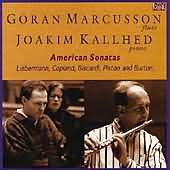Media : Listen
Goran Marcusson, flute; Joakim Kallhed, piano
The following work appears on American Sonatas, Intim Musik IMCD 034 (Sweden, 1994) with Lowell Lieberman Sonata, Aaron Copland Duo, Walter Piston Sonata, and Eldin Burton Sonatina. Liner notes by P G Berfors (translated by Linda Schenck).
Although I was not given any particular guidelines as to the nature of the composition, I felt strongly that the work should be musically more challenging than a traditional virtuosic competition piece. The Italian title means “transverse, lying across, breadth” and suggests not only the flute itself but also a music that extends over diverse feelings and ideas — ideas such as “musical landscapes.” In this work I blend Japanese transparency, in the sense of stillness, with the heroic and open musical landscape suggested by American harmonies of the 1930s and ’40s.
Composer’s Thoughts: Juxtaposed Landscapes
Performance Guidelines
The following notes might be helpful in preparing a performance of Traverso:
• long unison lines – unison doublings (tonal effects in the piano/flute unisons) – sweeping, overlapping – a totally lyrical piece – dissonance and disjunct melodic lines
• blocks (organ-like) of chords in piano from which flute emerges and spirals out, pulling away from chords, like energy being sucked out . . .
• some ideas affirm, unravel earlier ideas, anticipate others, gear up and move toward ecstatic moments . . .
• piano pedal markings bring out sonorities and colors in significant structural places throughout the work; textures are important; balance is important – intonation, balance and blend
• as in Tenzone, for two flutes and piano (1975) (see program note for Tenzone), the piano is also the rhythmic impetus
• there are no multiphonics or extended techniques as in Tenzone, but there are special fingerings, fluttertonguing, and timbral play of harmonics
• attention to pitch and levels of nuance and attack; motives (atonal) are distinguished in either exact or altered form
• large leaps cover entire range of the flute
• frequent tempo changes (19 in 7 minutes); numerous meter changes (multi-metric) – mm.92, 139
It might be helpful when listening to this piece to know that there are three basic “themes”: an upward moving scale, mm. 3-4,

followed by an arch-like figure, m. 8,

which connects into a darker, three-note motive, mm. 12-13 –

all of which are extended and intertwined into the larger structure, which, in a way, is similar to sonata-allegro form: an introduction-exposition of the three ideas; development of these ideas; then a recapitulation of especially the darker motive; and finally a coda.
Traverso was written just after Piano Sonata (1986; revised 1987) and was based, in part, on oiginal sketches for Piano Sonata that were never used in that work; both pieces were the first works that struggled with a new way to write purely abstract, absolute instrumental music after having completed Tight-Rope, an opera in nine uninterrupted scenes (1985), based on a text by Henry Butler, with its reliance on text, characters, story, etc., in order to arrive at musical structure, form and idea.

